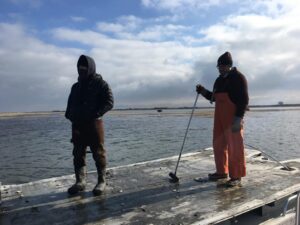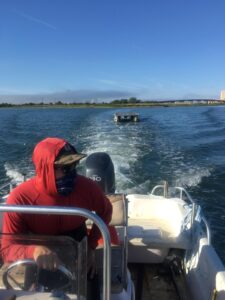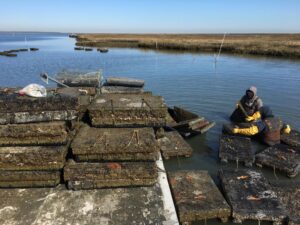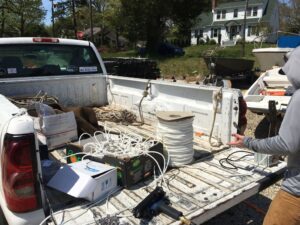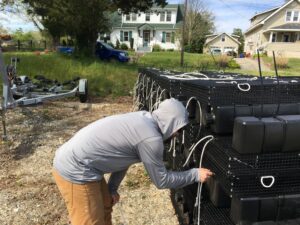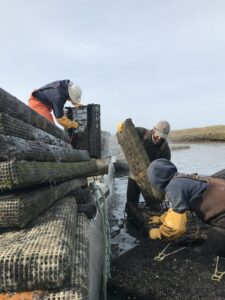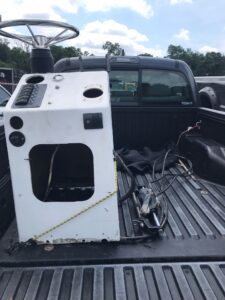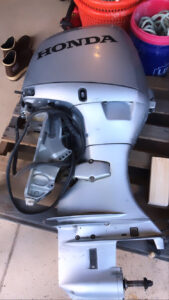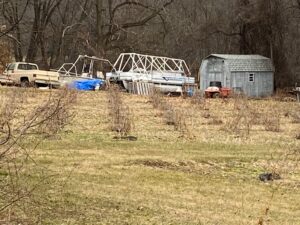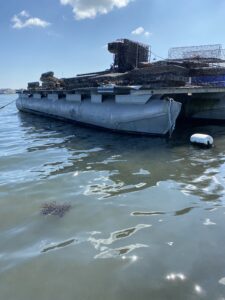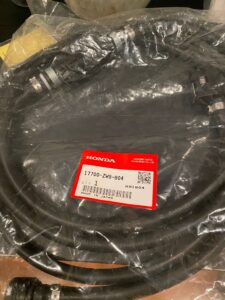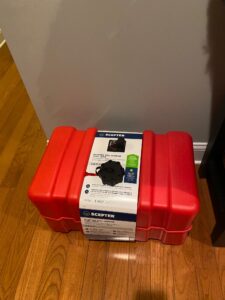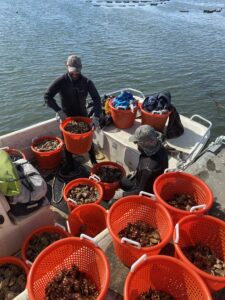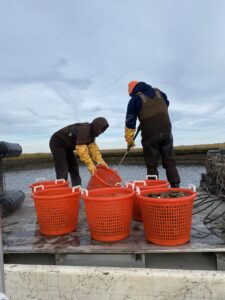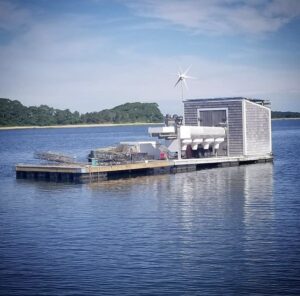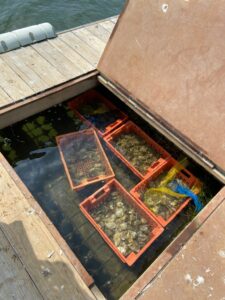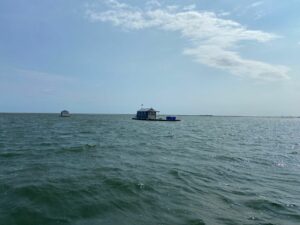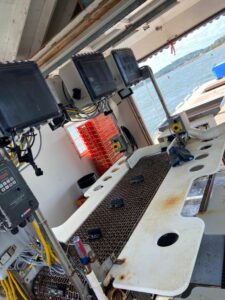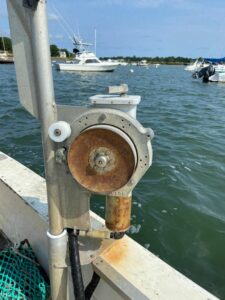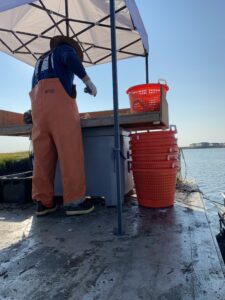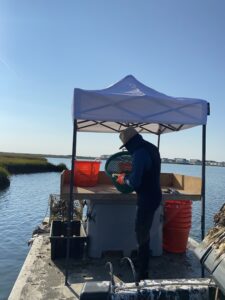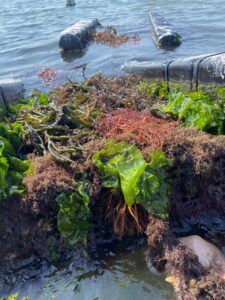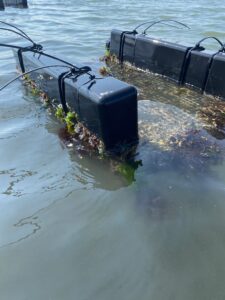Final report for FNE21-985
Project Information
This project sought to show small-scale oyster farmers the benefits of using a pontoon boat based mobile farming unit to manage husbandry and equipment maintenance with a limited farm workforce. Identifying used and second hand gear/materials this project's goal was to offer an economical example for small oyster farms in the Northeast and beyond. With the introduction of the unit we spend 40% less time handling and processing oysters for harvest. This not only benefits farm labor efficiency but most importantly our food safety protocol with regard to time to temperature (Harvested and bagged oysters being placed in iced tote for landing). In early June 2022 we compared overwintered product with our controls and saw 10% less mortality within the new husbandry method. Although the oysters were growing at a 5-6% slower rate, the oysters were uniform in shape, stronger, and an almost 50% reduction of pests such as boring sponge.
In the month since the conclusion of this project we have visited 2 farms in New Jersey and discussed our project and results. We have also been in contact with 1 farm in Massachusetts sharing our results. Our plan is to first share our project with our direct community of farmers in NJ Aquaculture Association then further to the East Coast Shellfish Growers Association (ECSGA). With this SARE opportunity we improved our methods allowing us to handle the expansion of our farm. We are looking forward to sharing our results further.
This project seeks to show small-scale oyster farmers the benefits of using a pontoon boat based mobile farming unit to manage husbandry and equipment maintenance with a limited farm workforce. This unit will enable small farms like ourselves to handle large amounts of husbandry work and farm maintenance in any area of the farm with the ability to move it easily. The unit in this project will have the added assistance of cranes and haulers so heavy oyster containing equipment can be tended to quickly then returned to the water to grow. This is a solution to allow farmers to work their farms more productively, save them physical strain and be financially viable for a typical small oyster farm of 1-10 employees. Beyond building and demonstrating the use of this tool, the secondary objective will be to document and quantify its potential cost and labor savings in a small farm setting.
The annual sales of domestic marine aquaculture products have seen double digit increases for over a decade. Throughout the Northeast coastal areas are seeing growth in shellfish aquaculture activity, predominantly oyster farming.[1] Shellfish aquaculture is primarily a business of a small-scale often family-owned farms with aquaculturists commonly coming from commercial fishing families and communities.[2] North America as a whole sees similar trends in aquaculture and small-scale operations. A survey conducted in Alaska showed 62 farms operating under 10 acres and less than 15 operating over 10 acres. [3] In the Northeast specifically the commercial wild fisheries sector has lost jobs in recent years due to declining fish stocks. Many of these fishermen are now growing oysters, clams, mussels, scallops, and seaweed as a means for a more reliable and stable life in these coastal communities. This shift to aquaculture from other fisheries also reflects a generational change. For example, the average fisherman in Maine is in their mid-50s; most working in aquaculture are in their mid-30s.[4]
The goal is to share a process for small-scale aquaculture farmers to improve productivity with their limited labor force. The problem is that oyster farms in the Northeast are largely small operations and increasing production means increasing the physical toll on the farmer(s) and doing so within a finite amount of available work time. The opportunity is to provide farmers a way to reduce physical strain from manually tending oyster growing gear, and enable higher quality and faster crop yields in a way that is financially viable at the small farm level.
A 2016 survey by New Jersey SeaGrant returned responses from 20 total aquaculture farms, totaling 37 full-time employees.[5] Averaging less than 2 full-time employees per farm it is clear that efficient farming techniques are of vital importance to farmers. Farm-raised oysters need to be planted then meticulously cultured to bring a strong and healthy oyster to market as soon as possible. The longer a crop stays in the water the more susceptible it becomes to a large number of marine pests that threaten its health. This is especially the case in floating equipment systems during summer months where oysters are feeding at a maximum. High water temperatures and fast growing will result in a build-up of metabolites, which should be removed on a weekly basis.[6] These pests can degrade shell strength, weaken the animals' only ability of defense (closing its shell), and reduce the appeal for half-shell presentation. If these issues are not controlled, they have the potential to overwhelm an oyster farmer and cause them to incur very high labor cost or loss of crop from increased mortality. Pro-active control of fouling is essential, with routine control measures taken before fouling becomes problematic.[7] As farms increase production, they add to the pressure to maintain a larger crop and increase the physical strain on the farmers to work more equipment in the same available time.
[1] https://www.fisheries.noaa.gov/national/aquaculture/us-aquaculture
[2] https://www.northeastoceancouncil.org/wp-content/uploads/2013/03/Aquaculture-White-Paper.pdf
[3] https://www.afdf.org/wp-content/uploads/2b-Alaska-Shellfish-Farm-Size-Feasibiliy-Study.pdf
[4] https://www.afdf.org/wp-content/uploads/14d-The-Political-Economics-of-Marine-Aquaculture-in-the-US-Knapp-and-Rubino-2016.pdf
[5] http://njseagrant.org/wp-content/uploads/2018/04/NJAquacultureSurvey2016.pdf
[6] https://wsg.washington.edu/wordpress/wp-content/uploads/publications/Small-Scale-Oyster-Farming.pdf
[7] https://www.researchgate.net/publication/301625835_OFF-BOTTOM_OYSTER_FARMING
Our aquaculture farm began in 2015 and over following four years we saw increment growth and expansion annually, in 2019 being certified to distribute our products directly. All products produced on our farm are sold farm-direct and it is all manned through a small distribution space. The business continues to be part-time with the goal to go full-time. The results of this SARE funding has been the single largest benefit in helping our farm grow.
Cooperators
- - Technical Advisor
- (Educator and Researcher)
Research
Prior to this project our farm utilized approximately 200 individual oyster growing cages which when laden weigh anywhere from 50-200+ lbs. As of Spring 2021 we have 350 deployed. As mentioned, farm personnel and labor capacity did not increase. Our farm operations all took place at low-tide in 2.5-3 feet of water and were conducted by individuals working in wetsuits, in the water. An average day included manually flipping all cages into air-drying position, husbandry work/maintenance to approximately 15 cages, and harvesting/packing 1000-2000 market-sized oysters.
The mobile work unit utilized was a 24 foot pontoon boat adapted for these tasks which are common to all subtidal, floating cage based farms. In the Northeast similar subtidal production methods are commonly utilized throughout Massachusetts, New York, Rhode Island, & Maine in addition to New Jersey. Prior to the start of this project farm contacts in both New Jersey and Massachusetts expressed interested in our project. This collaboration turned into a working relationship where we visited their operations to see different techniques/methods but to also share our project details. The unit has mechanical hauling equipment to aid in bringing large quantities of equipment onboard simultaneously. Added work surfaces were added that included shaded coverings and commercial ice totes. This enabled us to harvest and cool large numbers of oysters in a rapid and safe manner. With this unit we had the ability to move around the 6-acre farm and cover numerous tasks in multiple locations in a given workday.
In early 2021 our farm doubled in size in terms of animals and quantity of gear used on the farm. In late winter to early spring 2022 it will again double in size and the ability to move around the farm to different locations within our 6+ acres has proven vital to ensure continued strict husbandry practices.
Beginning April 2021 we began exploring outlets to acquire materials for our unit in a cost effective manner as described in our project overview. Highlights:
- We identified the style rigging and rope to haul long lines in unison onto the work unit. To be utilized manually then incorporated into the mechanical hauling system. (See attached photo showing rig assembly).
- Custom long lines rigging & splicing. These lines were specifically designed to be hauled on deck of the unit all at once. This totaled up to 15 growing cages at a time. Previously, cages were disconnected manually in the water and worked in pairs on board our work boat. This had the strongest impact on the operation; transitioning from working a single line in a tide cycle to effectively working 3 lines. This new rigging enabled large scale work to be done regardless of tide cycle.
- Next we acquired a second hand utility pump to be utilized on board the platform for various large-scale washing tasking. For both gear maintenance as well as husbandry.
- At this point it was mid June and we found a suitable pontoon to begin the process. See pontoon photo in previous owner's yard before it was in water and dismantled by our team. The pontoon owner needed the pontoon to be moved from the dock it was stored at immediately so we quickly moved at the opportunity as it was local and close by. Owner allowed us to use and begin modifications prior to final terms of sale being finalized as a gesture for moving it so quickly. Modifications included removing all non-working equipment including seats, framing and motor.
- We installed fixed anchors to moor the pontoon to on our farm, while waiting for continued pontoon construction and updates. Immediately we began utilizing the unit in its current state. See 2 attached photos of gear drying on deck the unit, team washing gear with new pump system, and team splitting seed oysters into new gear. At this point we were already seeing efficiencies increase by more than 100%. With electric hauling we predict we will surpass our projected gear husbandry number, and increase efficiencies another 100-150%.
- In early May we acquired a second hand motor to power our mobile unit (see photo) followed by steering and console (see picture).
- Custom line hauler ordered in December, however Covid as well as serve supply chain issues have delayed the manufacturing by 2-3 months.
- Custom long lines have been designed and will be completed through February 2022. These lines were incorporated with rigged cages and hauling system (pictured below)
- Rutgers University Shellfish Laboratory Research and Hatchery Manager, Sean Towers toured our farm operation with a focus on the opportunities this mobile unit will present to us. Ideas and suggestions on layout have been an open dialogue with Sean ever since.
- Visit to Monks Cover Oyster Farm, Bourne Massachusetts and spent the day on their operation. Although they do not have a mobile unit as we are building they have a stationary float (as we described in our initial report) moored direct on their farm. This dock and enclosed space offered immense takeaways including new ideas for system flow on deck our as well as nursery systems within the floating unit to rear juvenile oyster seed. This farm is also at the forefront of some unique sustainable aquaculture practices - including a completely solar powered set-up on the stationary unit.
- Visit to Merry Oyster Farm, Duxbury Massachusetts. Visit included sharing information and practices on harvesting and packing, also on their stationary farm unit. This visit we saw an automated oyster counting machine this small farm utilized on board their unit that substantially benefited their harvest and packing efficiency given their labor force. We also saw wet holding storage on the unit where the team can harvest product, bag it and leave it submersed in cages build into the unit. Another major finding from this visit was that it gave us the style, design, and manufacturer for our hauling system. Pictured below
- Strategic planning for layout began and pontoon placed on land for further assembly and all mechanical construction, and hauling system incorporation.
- Jan 22 through Late April 2022, faced numerous setbacks in the project timeline goals due predominantly to the effects of Covid-19. Our mechanics business ceased operation being the foremost leaving us scrambling to find an operation with an open schedule to accommodate our project.
- All work pivoted on the farm and without immediate installation of our motor we used our 19ft skiff to tow the mobile unit to sections of the farm where it would be utilized. Although slower we began realizing our production and efficiency goals in the manner.
- Shaded coverage, culling table(s) and insulated coolers were incorporated into the unit further increasing efficiency of harvest/cull but most importantly time to temperature. Product was pulled from the water, counted, washed, bagged then into ice in an average of 15 minutes. Previously without the unit this process took twice the time.
Utilizing the mobile unit we estimated that we would more than double efficiency for a typical daily regimen of husbandry work and maintenance on 35-40 cages, harvesting 2000-3000 market-sized oysters and positioning 75% more cages to air dry. Harvesting upwards of 30 bags in a day has proven completely obtainable but is often to be not necessary. As we continued with this project the husbandry workflow enabled the workers to do less more often and stage market-sized product pre-packed and waiting on the farm for harvest at a later date. This had a huge impact and improved quality of life for all. The unit not only allowed better maintenance day-to-day but we also now have the ability to leave gear on the unit for a 24-hour period to air dry and kill excessive levels of marine fouling.
Included are two photos of culling/harvesting work being conducted on the unit. Prior to this project, work was conducted on a 19 foot boat where workers worked in exceedingly limited space to cull and pack. The photos demonstrate the added unit that enables one worker to pull oysters from the water, cull, pack and wash the product in 40% less time than previously, all while maintaining an upright comfortable working station with a waist high table top and fully shaded awning. And the 19 foot boat can be handling other tasks in another area of the farm.
These goals will be accomplished by the ability to haul entire long-lines (approx. 12-15 cages each) on board the mobile unit with the assistance of mechanical hauling equipment. The unit will enabled the team to engage in farm work task previously accepted as unmanageable in high-tide depths of over 6 feet. This freed us from being limited to all work time by the tidal state. The introduction of mechanical assistance made working quicker and increased individual work efficiency and safety due to reduced fatigue.
Air drying a larger number of oysters coupled with the ability to complete husbandry and maintenance work on a larger number of oysters led to higher quality and increased crop yields. With the new method all gear was worked/maintained once every 12-14 days. Previously, gear on average would spend as much as 21 days untouched.
During high-season for oyster growth these new maintenance and husbandry processes mitigated marine grass, sponge, and tunicate growth that would previously overtake the equipment, weighing the gear down and choking off the flow of waterborne nutrients to the animals. In addition to increased frequency of farm work on each individual cage as well as new large scale air drying, the mobile unit enabled more frequent power-washing of equipment to mitigate marine/biofouling on equipment and oysters. This large stable work platform enabled farmers to adjust the density of animals in each cage to optimize the oyster’s ability to feed and grow, rather than having to do this bulk sorting work while standing in the water using baskets etc. at a very low level of efficiency.
We maintained a line of 3 total cages as our control. Husbandry tasks were completed once per month and the controls and the fouling and growth details show the benefits of the new system. The control gear was severely always fouled to the extent where air drying did not do much to mitigate. Growth of oysters inside the cages was disproportionate and the excessive fouling was not limited to the outside of the gear but also inside.
Like-sized oysters using the new system grew at a rate of 5-6% slower but showed uniform shape and strong shell strength, minimal fouling and virtually no boring sponge. Previous years and methods saw boring sponge affecting 5-7% of oysters. Through 2022, we have sampled gear every 3 weeks and it has been present in 3-4% of oysters. The new system produces a stronger healthier oyster. As mentioned, with continuous husbandry and drying practices in place, the growth rate is slightly slower, but on the farm as a whole, we reported an average mortality nearly 10% less than the control. Two photos are included, one of new system results and one of the control gear. (Example photos included)
Pre-assembled rigging for line set up are now organized and stored on the unit. Repairing equipment happens quickly, and no longer is gear staying deployed for excessive periods of time in need of repair. This reduced instances of lost equipment and also equipment being out of service for extended times. Both which contribute to decreased costs and increased efficiency. Prior to the use of this unit there was not space for storing repair material on our 19ft boat. We were also unable to haul gear on boat the boat and leave it there for days at a time. We would take the equipment to land via boat and truck it back to our homes. This time off the farm for this equipment was excessive. When gear was taken off the farm previously it would be emptied into adjacent gear, often leading to overcrowding. This coupled with excessive time on land was negative in all aspects for the animals. Now the repairs take place with no temporary storage/overcrowding of animals then the gear is returned to the farm in the proper state.
Having the mobile unit on the farm benefited the farms compliance with all current food safety initiatives and has turned into the one of the key areas of success in this project. Time to product being placed in a insulated iced cooler was cut in half. This lead to further efficiencies with product arriving to mechanical refrigeration a a rapid rate.
With the increases of gear and animals on the farm if everything remained constant and without this project we calculated that husbandry and farm maintenance given the expansion would necessitate hiring 2 additional part-time farm workers to work year-round 2-3 days per week. This expense was estimated at roughly $18,000-$34,000 annually.
Often, field repairs were almost always identified and hastily completed out of necessity. There was positive change with this unit in regards to both preventative maintenance and what we now see as the new normal for field repairs. One example of this is arriving on the farm site to a line of cages pulled from their anchor and attachments broken. The line was pulled to the unit, attachments repaired and then redeployed, and workers were still able to complete husbandry work for the day. This would have been a setback of a day’s work previously.
The objective of this project was to show small-scale aquaculture farms a financially-viable way to increase productivity and decrease both short and long term physical strain on workers to increase longevity. The above results show that we met our objective. Please also refer to results and discussion portion for more highlights/details for our farm journal.
Education & Outreach Activities and Participation Summary
Participation Summary:
August 6 - Rutgers Shellfish Lab Researcher and Manager Sean Towers toured our operation to get a better understanding of our plan.
The New Jersey/Rutgers Aquaculture Innovation Center which Sean manages is the states only large-scale aquaculture seed hatchery. Sean’s position the involves a significant amount of communication with a large amount of NJ-based and other shellfish farms in the Northeast who use the NJ AIC as a resource. Based on his experience dealing with many farms we felt he would be a great resource to share our approach and methods for a critical response. Sean’s collaboration with these countless farms also offers an excellent outreach vessel to share our project outcomes.
We documented some process photos and the equipment in use periodically through our Instagram and Facebook pages. We will be attending an NJ Aquaculture Association meeting with other growers on 10/28. Lastly, we plan to share a condensed version of our project on both the NJ Association and ECSGA listservs. We are exploring other outlets such as the Shellfish Growers Climate Coalition which we are members of.
Learning Outcomes
Our outreach activities further established our stance that this project is the foundation for our small farm's growth. The units on the farms we visited included staged product submerged storage, mechanical counting equipment, and also solar and wind power nursery systems. These farms both employ the same or fewer full-time workers than ours and produce 3-8x the total production we do on ours. On these visits we were not only seeing best practices and taking notes on our existing project tasks but also additions to this equipment both short term and long term.
We continue to collaborate with both of these farms on a monthly and sometimes weekly basis. It has turned into a working relationship where one farm is looking to move away from the stationary float an adopt a mobile unit. Their farm continues to grow in size similar to ours and the identified food safety benefits shown in this project (time to product being iced) is pushing them to adopt a mobile unit.
Project Outcomes
All members of the farm have reported significant changes in daily life both on and off the farm as a result of this project. As the farm continues to grow in size yearly, we have proven that increasing efficiencies over various areas at the farm level allows our current labor force to handle this growth. We have also proven that it will not become a burden on employee morale and the production does in fact see countless positive benefits from implementing these changes surrounding the mobile unit. In discussions among the four farmers in regard to this project we’ve stated things such as “We are no longer working for the moment, rather for the following weeks and months”.
Looking back over the course of this project we feel that although we faced some significant and unplanned changes affecting our methods we were able to arrive at a successful conclusion that has strongly benefited the quality of our crop and the well being of each farm worker. These benefits will only continue to be expanded upon as our farm operation grows.
One major challenge we faced with this project was the uncertainty that the Covid-19 pandemic brought and also the economic factors affected by it. In 2021 and 2022 the US saw labor costs increasing quarterly from 9-12%. Shop rates for fabrication and mechanical work used in our forecasting were based on 2019 and some 2020 rates/data. We have witnessed surging raw material prices; such as 2022 raw stainless steel prices are averaging 45% higher than early 2021. These examples put stress on our ability to complete the project within the budget, we are gracious for the assistance of the SARE team for assisting our farm with budget adjustments and allowing for project extensions.
Although we faced these changes and future farmers engaging this practice must use budget adjustments based on the above details it is still an area where small oyster farms are able to get a leg up on expansion while maintaining the same labor team size. The results clearly indicate increased efficiencies enabling farms such as our to increased crop yields while maintaining quality.
